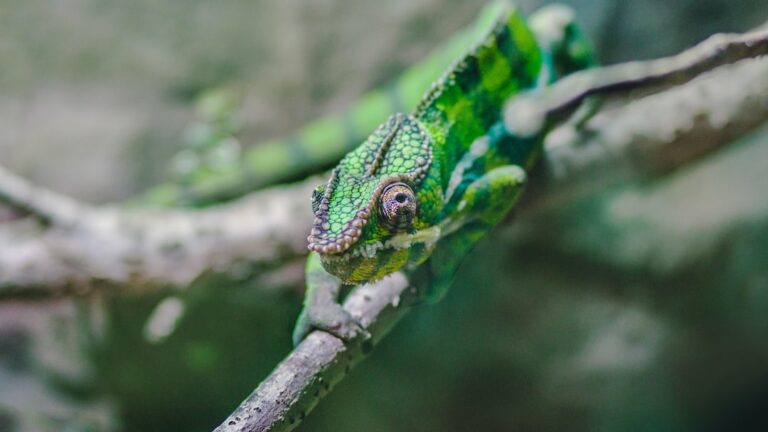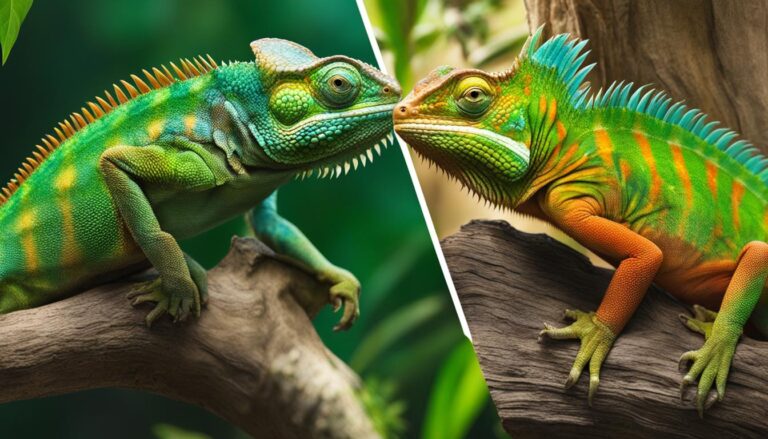Are Chameleons Capable of Love?
Chameleons are fascinating creatures known for their ability to change color and blend into their surroundings. They belong to the family Chamaeleonidae and are native to Africa, Madagascar, and parts of southern Europe and Asia. Chameleons have unique characteristics that set them apart from other reptiles, such as their independently moving eyes, long tongues, and prehensile tails.
The purpose of this blog post is to explore the emotions and relationships of chameleons. While it is commonly believed that reptiles do not experience emotions like mammals do, recent research has suggested that some reptiles may indeed have complex emotional lives. By examining the behavior and biology of chameleons, we can gain a better understanding of their emotional capabilities and the nature of their relationships.
Table of Contents
The Science of Love: Can Chameleons Experience It?
Love is a complex emotion that is often associated with mammals, particularly humans. However, many animals also form strong emotional bonds with their mates and offspring. When it comes to chameleons, the question arises: can they experience love?
While it is difficult to measure emotions in animals, studies have provided some insights into chameleon behavior and emotions. For example, male chameleons have been observed engaging in elaborate courtship rituals to attract females. These rituals involve displays of color changes, head bobbing, and body movements. This suggests that chameleons may have a strong desire to mate and form relationships.
Furthermore, chameleons have been observed displaying territorial behavior and aggression towards other males. This indicates that they may have a sense of ownership or attachment to their territory, which could be considered a form of love or attachment.
However, it is important to note that these behaviors do not necessarily indicate the presence of love as humans understand it. Love is a complex emotion that involves a range of cognitive and emotional processes, which may not be present in chameleons. While chameleons may have some capacity for emotional experiences, it is unlikely that they experience love in the same way that humans do.
The Role of Hormones in Chameleon Behavior
Hormones play a crucial role in animal behavior, including the formation of social bonds and the regulation of emotions. In chameleons, several hormones have been found to influence their behavior and emotions.
One such hormone is oxytocin, often referred to as the “love hormone.” Oxytocin is known to play a role in social bonding and attachment in mammals, including humans. Studies have shown that oxytocin levels increase during social interactions and can promote feelings of trust and bonding.
In chameleons, oxytocin has been found to be present in their brains and may play a role in their social behavior. For example, male chameleons have been observed releasing oxytocin during courtship displays, which may help facilitate the formation of social bonds with females.
Another hormone that affects chameleon behavior is testosterone. Testosterone is associated with aggression and territorial behavior in many animals, including chameleons. Male chameleons have higher levels of testosterone during the breeding season, which may contribute to their aggressive behavior towards other males.
Overall, hormones play a significant role in shaping chameleon behavior and emotions. While more research is needed to fully understand the complexities of hormone regulation in chameleons, it is clear that hormones play a crucial role in their social interactions and emotional experiences.
The Importance of Social Interaction in Chameleons
Chameleons are social creatures that thrive on social interaction. In the wild, they live in small groups or colonies and engage in various social behaviors such as territorial displays, courtship rituals, and communication.
Social interaction is essential for chameleons for several reasons. Firstly, it allows them to establish and maintain social hierarchies within their groups. This hierarchy helps to reduce aggression and promote cooperation among group members.
Secondly, social interaction provides chameleons with opportunities for mating and reproduction. Male chameleons engage in elaborate courtship displays to attract females, and social interaction allows them to find suitable mates.
Thirdly, social interaction provides chameleons with opportunities for learning and development. Young chameleons learn important skills and behaviors from their parents and other group members, such as hunting techniques and predator avoidance strategies.
On the other hand, isolation and lack of social interaction can have negative effects on chameleon behavior and emotions. Studies have shown that isolated chameleons exhibit higher levels of stress and aggression compared to those living in social groups. They may also have difficulty reproducing and forming social bonds.
Therefore, it is crucial to provide chameleons with opportunities for social interaction in captivity. This can be done by housing them in groups or providing them with visual barriers that allow them to see and interact with other chameleons.
How Chameleons Communicate with Each Other
Communication is an essential aspect of any social species, including chameleons. While they may not have the vocal abilities of mammals or birds, chameleons have developed unique ways of communicating with each other.
One of the most well-known forms of communication in chameleons is their ability to change color. Chameleons use color changes as a means of communication, both to attract mates and to signal their intentions or emotions. For example, a male chameleon may display bright colors to signal his dominance or interest in a female.
Chameleons also communicate through body language and physical displays. They may engage in head bobbing, body movements, and posturing to convey messages to other chameleons. These displays can be used to establish dominance, signal aggression, or initiate courtship.
In addition to visual communication, chameleons also use chemical signals to communicate with each other. They have scent glands on their bodies that produce pheromones, which can convey information about their reproductive status, territorial boundaries, and social hierarchy.
Overall, communication plays a vital role in chameleon relationships and emotions. It allows them to establish social bonds, coordinate behaviors, and convey important information to other chameleons.
The Significance of Courtship Rituals in Chameleons
Courtship rituals are an essential part of the mating process in many animals, including chameleons. These rituals involve a series of behaviors and displays that serve to attract mates and establish social bonds.
In chameleons, courtship rituals are often elaborate and visually striking. Male chameleons engage in displays of color changes, head bobbing, and body movements to attract females. These displays serve as signals of their fitness and genetic quality.
Courtship rituals also play a role in establishing social hierarchies within chameleon groups. Male chameleons may engage in aggressive displays towards other males to establish dominance and secure mating opportunities.
The significance of courtship rituals goes beyond mere reproductive success. They also serve as a means of communication and emotional expression. By engaging in these displays, chameleons are able to convey their intentions and emotions to potential mates.
Furthermore, courtship rituals can have an impact on the emotional well-being of chameleons. Studies have shown that male chameleons that engage in successful courtship displays experience an increase in testosterone levels and a decrease in stress hormones. This suggests that courtship rituals may have a positive effect on the emotional state of male chameleons.
Do Chameleons Form Bonds with Their Offspring?
Parental bonding is a common phenomenon in many animal species, where parents form strong emotional bonds with their offspring. This bonding is often essential for the survival and development of the young.
In chameleons, the level of parental care varies among different species. Some species of chameleons provide no parental care, while others may exhibit varying degrees of care.
Studies have shown that female chameleons may lay their eggs in nests or burrows and provide no further care to their offspring. Once the eggs hatch, the young chameleons are left to fend for themselves.
However, there are some species of chameleons that exhibit more extensive parental care. For example, female Jackson’s chameleons have been observed guarding their eggs and providing protection to their young after they hatch. This suggests that some chameleons may form bonds with their offspring and engage in parental care.
It is important to note that the concept of parental bonding in animals may differ from the human understanding of love and attachment. While chameleons may exhibit behaviors that indicate a level of care and protection towards their offspring, it is unclear whether they experience the same emotional attachment as mammals do.
The Impact of Environment on Chameleon Behavior
The environment plays a significant role in shaping animal behavior, including that of chameleons. Chameleons are highly adapted to their natural habitats, and changes in their environment can have a profound impact on their behavior and emotions.
One of the most obvious ways in which the environment affects chameleon behavior is through color change. Chameleons use color change as a means of camouflage and communication, allowing them to blend into their surroundings and signal their intentions or emotions. Changes in the environment, such as alterations in light levels or temperature, can trigger color changes in chameleons.
The availability of resources in the environment also influences chameleon behavior. For example, chameleons may exhibit different foraging behaviors depending on the abundance of food sources in their habitat. They may also adjust their activity levels and social interactions based on environmental factors such as temperature and humidity.
Furthermore, changes in the environment can have a direct impact on chameleon emotions. For example, exposure to stressful or unfavorable conditions can lead to increased levels of stress hormones and negative emotions in chameleons. On the other hand, a favorable and enriched environment can promote positive emotions and well-being.
Therefore, it is important to provide chameleons with an environment that meets their specific needs and allows them to engage in natural behaviors. This includes providing appropriate lighting, temperature, humidity, and enrichment to promote their physical and emotional well-being.
Chameleon Relationships: Examining the Evidence
The nature of chameleon relationships is complex and multifaceted. While they are social creatures that engage in various social behaviors, the exact nature of their relationships is still not fully understood.
Research on chameleon relationships has primarily focused on courtship and mating behaviors. Male chameleons engage in elaborate displays to attract females, and successful courtship often leads to mating. However, it is unclear whether these relationships extend beyond the mating period.
Some studies have suggested that chameleons may form long-term social bonds with their mates or group members. For example, male Jackson’s chameleons have been observed guarding their mates after mating, suggesting a level of attachment or bonding.
Furthermore, studies have shown that chameleons can recognize familiar individuals and display preferential treatment towards them. This suggests that they may form social bonds and establish relationships based on familiarity and previous interactions.
However, more research is needed to fully understand the complexities of chameleon relationships. It is unclear whether these relationships are based on emotional attachment or simply serve functional purposes such as mating or resource sharing.
Exploring the Complexities of Chameleon Emotions
In conclusion, chameleons are fascinating creatures with unique characteristics and behaviors. While it is difficult to measure emotions in animals, studies have provided some insights into the emotional lives of chameleons.
Chameleons engage in various social behaviors, communicate through visual and chemical signals, and form social bonds with their mates and group members. Hormones play a crucial role in shaping their behavior and emotions, and the environment has a significant impact on their well-being.
While chameleons may not experience emotions in the same way that humans do, they do exhibit behaviors that indicate a level of attachment, social bonding, and emotional expression. Understanding the complexities of chameleon emotions is not only fascinating but also important for their welfare in captivity.
By studying chameleon behavior and emotions, we can gain a better understanding of the emotional lives of animals and promote their well-being in captivity. It is crucial to provide chameleons with appropriate social interaction, environmental enrichment, and care to ensure their physical and emotional health.
If you’re interested in learning more about reptiles and their behaviors, you might find the article “Are Chameleons Capable of Love?” on Reptile Friend intriguing. However, if you’re also curious about the eating habits of iguanas, you should check out their article on whether iguanas eat meat or not. It provides valuable insights into the dietary preferences of these fascinating creatures. Click here to read more about it.







